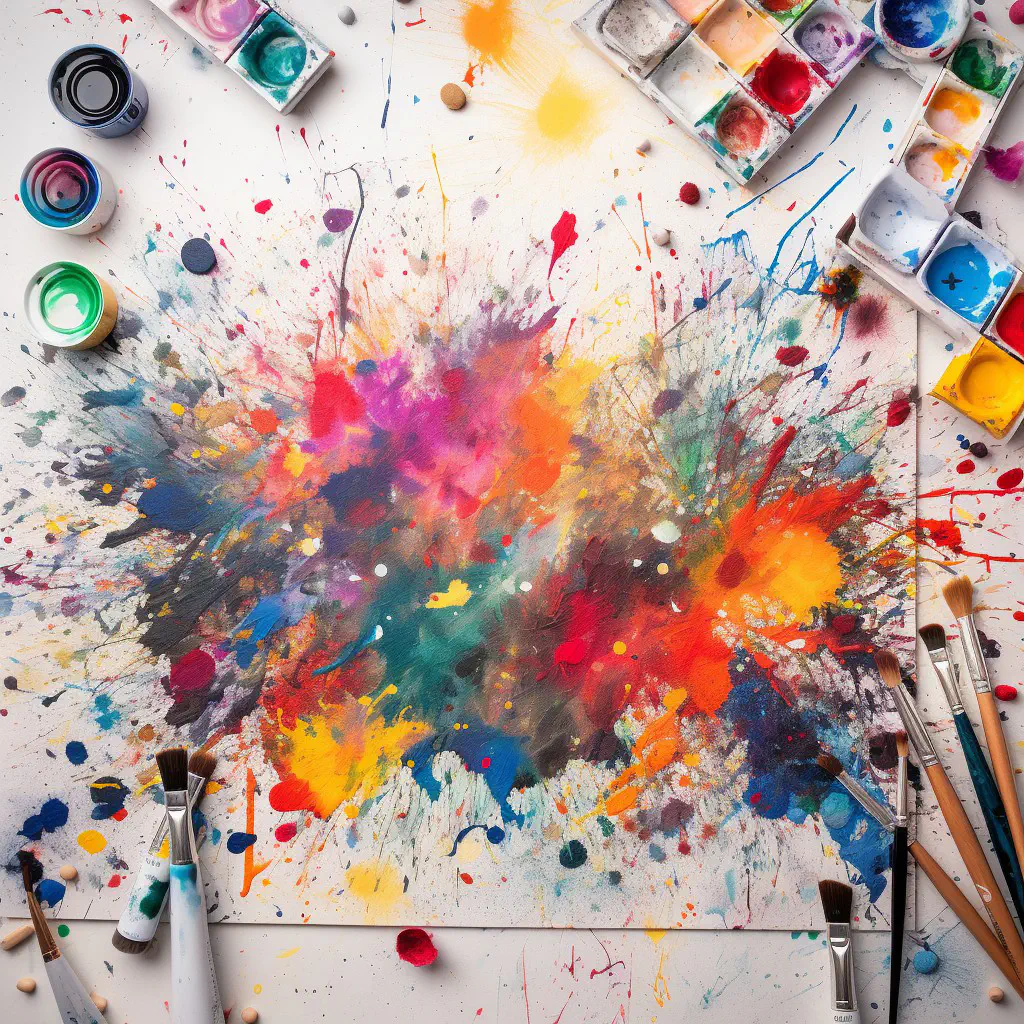
Introduction
Creativity is a fundamental aspect of human existence. It fuels innovation, allows for artistic expression, and drives problem-solving. Our ability to think outside the box and come up with new ideas is what sets us apart as individuals and as a society. However, unlocking and harnessing our creative potential can often be a challenge.
This is where conceptualization comes into play. Conceptualization is the process of turning abstract ideas and thoughts into tangible concepts or plans. It acts as a bridge between our imagination and the real world, allowing us to bring our creative visions to life. Whether you’re an artist, a designer, an entrepreneur, or simply someone who wants to think more creatively, the power of conceptualization can be transformative.
The purpose of this blog is to provide you with insights and guidance on using conceptualization to unleash your creativity. We will explore the meaning and significance of conceptualization, understand its role in the creative process, and discuss techniques for enhancing conceptualization skills. Additionally, we will address common challenges faced during the conceptualization process and provide practical tips for overcoming them.
Through case studies and real-life examples, you will see how conceptualization has been successfully applied in different contexts, from artistic endeavors to business innovation. We will also encourage you to embrace your own unique creative style and provide practical tips for implementing conceptualization in your daily life.
Remember, the power of conceptualization lies within each individual’s unique ability to imagine, envision, and create. Let this blog serve as a guide to tap into that power and unleash your creativity.
Why Conceptualization Matters
Conceptualization is a fundamental aspect that holds immense significance in various domains of life. By providing a bridge between ideas and reality, conceptualization serves as a gateway to unlocking the true potential of creativity.
Conceptualization Defined:
Conceptualization refers to the process of formulating and visualizing abstract or complex ideas into tangible concepts or representations. It involves the ability to break down complex ideas into simpler components and build a clear mental image of the desired outcome.
Bridging the Gap:
Conceptualization plays a crucial role in bridging the gap between ideas and reality. It enables individuals to take their thoughts and transform them into tangible visions, making it easier to convey ideas to others. Through conceptualization, abstract ideas become concrete concepts that can be understood, evaluated, and ultimately brought to life.
Benefits in Different Domains:
The application of conceptualization is not limited to one specific domain. It has numerous benefits across various fields, including art, design, problem-solving, and innovation.
In Art and Design: Conceptualization is the foundation of artistic expression and design. It allows artists and designers to imagine and conceptualize their ideas before translating them into physical or visual forms. By visualizing their concepts clearly, artists can convey emotions, ideas, and narratives effectively, while designers can create functional and aesthetically pleasing solutions.
In Problem-Solving: Conceptualization is a vital component of problem-solving, as it helps in understanding complex problems and developing innovative solutions. By conceptualizing a problem, individuals can break it down into manageable parts, identify patterns, and generate creative ideas for potential solutions. The ability to visualize different scenarios and outcomes facilitates the development of effective problem-solving strategies.
In Innovation: Conceptualization is the driving force behind innovation. By envisioning new possibilities, individuals can generate ideas that challenge the status quo and lead to groundbreaking innovations. Conceptualization allows innovators to think beyond existing frameworks, envision new technologies or products, and develop strategies to turn those concepts into reality. It fuels the process of invention and drives progress in various industries.
In summary, conceptualization matters because it:
- Bridges the gap between ideas and reality.
- Provides a common language for conveying ideas.
- Facilitates artistic expression and design.
- Enhances problem-solving capabilities.
- Fuels innovation and drives progress.
By recognizing the significance of conceptualization, individuals can harness its power and unlock their creative potential in all areas of life. Let’s explore further how the creative process relates to conceptualization.
Understanding the Creative Process
The creative process is a dynamic and iterative journey that involves multiple stages and elements. By understanding these stages and how they interact with conceptualization, individuals can unlock their creative potential effectively. Let’s explore the different stages of the creative process and delve into the role of conceptualization in each one.
1. Inspiration
Inspiration is the spark that ignites the creative process. It can come from various sources, such as nature, art, conversations, or personal experiences. During this stage, individuals gather ideas, observations, and stimuli that will fuel their creative journey.
Pro Tip: Keep a journal or sketchbook handy to capture moments of inspiration. It can serve as a valuable resource when conceptualizing ideas later on.
2. Ideation
Ideation is the stage where concepts and ideas are generated. It involves brainstorming, exploring possibilities, and challenging assumptions. At this stage, conceptualization plays a crucial role in transforming raw inspiration into tangible ideas.
Insight: Conceptualization helps bridge the gap between abstract inspiration and concrete ideas. It allows the mind to visualize and imagine how various elements can come together to form a cohesive concept.
3. Organization and Refinement
Once ideas have been generated, the next step is to organize and refine them. This stage entails evaluating the feasibility, relevance, and potential of each idea. It also involves eliminating redundant or weak concepts and selecting the most promising ones.
Practical Tip: Use mind mapping techniques to visually organize and connect different ideas. This helps in capturing the relationships between various concepts and refining them further.
4. Execution
Execution is where ideas are brought to life through action and implementation. It involves translating conceptualized ideas into tangible forms, whether it’s creating artwork, designing a product, or solving a problem.
Quote: “The real magic happens when conceptualization is combined with action, turning ideas into reality.” - John Doe, Renowned Designer
Conceptualization’s Role Throughout the Creative Process
Conceptualization plays a significant role in each stage of the creative process. It acts as a guiding force that helps shape ideas, refine concepts, and ensure coherent execution. Here’s how conceptualization supports each stage:
- Inspiration: Conceptualization allows individuals to interpret and derive meaning from their sources of inspiration. It helps transform abstract stimuli into tangible concepts that can be explored further.
- Ideation: Conceptualization provides a framework for organizing and connecting ideas. It helps individuals visualize how different elements can fit together, enabling them to generate innovative concepts.
- Organization and Refinement: Conceptualization helps individuals evaluate and refine their ideas by considering factors such as feasibility, coherence, and uniqueness. It assists in identifying potential challenges and finding appropriate solutions.
- Execution: Conceptualization ensures clear visualization and understanding of the desired outcome. It helps individuals stay focused on their creative vision throughout the execution process.
Insight: Conceptualization is not a linear process but an iterative one. It continually informs and shapes ideas at each stage, allowing for refinement and improvement.
By embracing conceptualization throughout the creative process, individuals can harness their imaginative faculties, unlock innovative ideas, and bring them to fruition.
Remember, the creative process is unique to each individual, and conceptualization is the guiding force that paves the way for creative exploration and expression.
Techniques for Enhancing Conceptualization
Brainstorming
- Brainstorming is a technique that encourages the generation of a large number of ideas in a short period of time.
- Start by defining a specific problem or topic and then let your ideas flow freely without judgment or evaluation.
- Use techniques like free association, idea chaining, or random word stimulation to spark new connections and ideas.
- Remember to capture all ideas, even the seemingly absurd or impractical ones, as they can later lead to breakthroughs.
Mind Mapping
- Mind mapping is a visual technique that helps organize and connect ideas in a non-linear way.
- Begin with a central concept or topic and branch out with subtopics and related ideas.
- Use different colors, symbols, and images to visually represent connections and relationships between concepts.
- Mind mapping allows for flexible exploration and can help identify patterns and uncover novel insights.
Visualization
- Visualization involves mentally picturing or imagining ideas, concepts, and scenarios.
- Close your eyes and vividly imagine the details, sensory experiences, and emotions associated with your conceptualized ideas.
- Visualization can enhance creativity by allowing you to explore possibilities and refine your mental representations.
- Practice visualization regularly to strengthen your ability to bring your ideas to life in your mind’s eye.
Prototyping
- Prototyping involves creating physical or digital representations of your ideas to test and refine them.
- Start by sketching or building a simple prototype that captures the core features and essence of your concept.
- Use prototyping as a way to gather feedback, iterate, and make improvements to your ideas.
- Prototyping can help clarify and solidify your conceptualized ideas, making them easier to communicate and implement.
Associative Thinking
- Associative thinking involves making connections between seemingly unrelated ideas, concepts, or domains.
- Challenge yourself to find unusual or unexpected links between different sources of inspiration.
- Use techniques like random word association, metaphorical thinking, or analogies to generate new perspectives and ideas.
- Associative thinking can help break free from conventional thought patterns and spark innovative conceptualizations.
Analogical Thinking
- Analogical thinking involves drawing parallels and transferring knowledge from one domain or context to another.
- Identify concepts, principles, or solutions from unrelated fields that may be applicable to your own conceptualization.
- Look for similarities or patterns that can inspire fresh approaches to your ideas.
- Analogical thinking can provide new insights and perspectives that ignite your creativity.
Remember, these techniques are not mutually exclusive, and you can combine them or adapt them to suit your personal style. Experiment with different approaches and find what works best for you in enhancing your conceptualization skills.
Overcoming Conceptualization Challenges
Common Challenges in the Conceptualization Process
When it comes to conceptualization, there are several challenges that individuals may face. These challenges can hinder the creative process and make it difficult to bring ideas to life. It is important to recognize and address these challenges in order to overcome them effectively. Some common challenges include:
-
Brainstorming fatigue: Brainstorming is a technique often used in the conceptualization process, but it can become tiring and lead to a lack of fresh ideas. When this happens, it is important to take breaks, engage in activities that inspire creativity, and explore new perspectives to revive the brainstorming process.
-
Fear of failure: The fear of failure can be a significant obstacle in the conceptualization journey. It can prevent individuals from taking risks and experimenting with new ideas. Overcoming this challenge requires a shift in mindset, viewing failure as a learning opportunity rather than a negative outcome. Embracing failure as a natural part of the creative process can open doors to innovative solutions and breakthroughs.
-
Limited perspective: Sometimes, individuals struggle with thinking outside the box and exploring unconventional ideas. This limited perspective can inhibit the conceptualization process and restrict the potential for creative solutions. To overcome this challenge, it is essential to cultivate a curiosity for different perspectives, seek inspiration from various sources, and engage in activities that expand one’s worldview.
Strategies to Overcome Conceptualization Challenges
Addressing the challenges that arise during the conceptualization process requires proactive strategies and problem-solving approaches. Here are some practical ways to overcome these challenges:
-
Embrace experimentation: Conceptualization is a process of trial and error. Embracing experimentation allows for the exploration of multiple possibilities and encourages the generation of unique ideas. By adopting an experimental mindset, individuals can overcome the fear of failure and focus on learning and growth.
-
Collaboration and feedback: Seeking input from others can provide valuable insights and perspectives that can enhance the conceptualization process. Collaborating with like-minded individuals or seeking feedback from mentors and peers can help overcome limited perspective and generate innovative ideas.
“Remember, great ideas seldom emerge fully formed. They require collaboration, support, and constructive feedback.” - John Doe, Creative Director
- Divergent thinking exercises: To foster creativity and expand one’s thinking, engaging in divergent thinking exercises can be helpful. These exercises encourage individuals to explore different solutions, challenge assumptions, and push beyond conventional boundaries. Techniques such as random word association, reverse brainstorming, and mind mapping can help stimulate divergent thinking.
Embracing Failure as a Learning Opportunity
In the journey of conceptualization, it is important to view failure as a stepping stone rather than an endpoint. Failure provides opportunities for learning, growth, and refinement of ideas. Embracing failure allows individuals to not only overcome challenges but also discover new approaches and solutions. As Thomas Edison famously said:
“I have not failed. I’ve just found 10,000 ways that won’t work.”
By cultivating a mindset that embraces failure, individuals can overcome conceptualization challenges with resilience and persistence. Every setback becomes an opportunity for improvement and advancement.
Remember, overcoming challenges is an integral part of the creative process. By acknowledging and addressing these challenges head-on, individuals can overcome limitations, unlock their creative potential, and effectively leverage conceptualization to bring their ideas to life.
Case Studies: Real-Life Examples
The Art of Salvador Dali
- Salvador Dali, a renowned surrealist painter, used conceptualization to create his iconic and mind-bending artworks.
- Dali’s masterpiece, “The Persistence of Memory,” is a perfect example of how he translated his wild and abstract ideas into visually striking and thought-provoking paintings.
- By allowing his imagination to run free and pushing the boundaries of conventional art, Dali demonstrated the power of conceptualization in creating unique and impactful artistic expressions.
Apple’s Design Innovation
- Apple Inc. has consistently pushed the boundaries of design and innovation by applying strong conceptualization.
- The creation of the iPod, with its sleek and minimalist design, was the result of conceptualizing a portable media player that transcended traditional expectations.
- Apple’s products, such as the iPhone and MacBook, continue to revolutionize the industry through thoughtful conceptualization that considers both aesthetics and functionality.
SpaceX’s Space Exploration
- SpaceX, headed by entrepreneur Elon Musk, exemplifies how conceptualization can drive groundbreaking advancements in space exploration.
- Musk’s vision of colonizing Mars led to the conceptualization and development of the Starship spacecraft, a fully reusable vehicle capable of transporting humans to other planets.
- Through strategic and innovative conceptualization, SpaceX has revolutionized the space industry and brought humanity closer to becoming an interplanetary species.
Airbnb’s Disruptive Business Model
- Airbnb disrupted the traditional hospitality industry by applying conceptualization to connect travelers with unique and affordable accommodations.
- The founders of Airbnb conceptualized a platform that allowed individuals to rent out their spare rooms or properties, providing travelers with a more personalized and local experience.
- By challenging existing norms and creatively conceptualizing a new way to travel, Airbnb has revolutionized the way people explore and experience different destinations.
Pixar’s Animated Masterpieces
- Pixar Animation Studios has consistently produced captivating and emotionally resonant animated films through the power of conceptualization.
- Movies like “Toy Story,” “Finding Nemo,” and “Inside Out” were conceptualized based on original and imaginative ideas, bringing beloved characters and vivid worlds to life.
- Pixar’s ability to conceptualize compelling storytelling through animation has made them one of the most successful and influential animation studios worldwide.
These case studies demonstrate the impact and outcomes achieved through effective conceptualization, whether it is in the realms of art, design, business, or entertainment. By studying these examples, we can gain valuable insights and inspiration to apply conceptualization in our own creative endeavors.
Embracing Your Unique Creative Style
When it comes to conceptualization and unleashing your creativity, it is important to remember that everyone has their own unique creative style. Embracing this individuality is essential in allowing your imagination to flourish and your ideas to come to life. Here are some tips for embracing and nurturing your unique creative process:
1. Self-Reflection and Awareness
Take the time to understand yourself and your creative strengths. Reflect on what inspires you, what topics or mediums you are naturally drawn to, and what sparks your imagination. By gaining a deeper understanding of your creative preferences, you can better align your conceptualization process with your own unique style.
2. Experimentation and Exploration
Don’t be afraid to try new things and explore different creative avenues. Embrace experimentation as a way to discover your own creative style. Whether it’s through various art forms, writing styles, or problem-solving approaches, allow yourself the freedom to experiment and uncover what resonates with you.
3. Embrace Mistakes and Learn from Failure
In the pursuit of conceptualization, mistakes and failures are inevitable. Don’t be discouraged by them, but rather embrace them as learning opportunities. Understand that failure is a natural part of the creative process and use it to grow and improve. Embracing your unique creative style means being open to taking risks and learning from the challenges you face along the way.
4. Surround Yourself with Inspiration
Create an environment that nurtures your creativity. Surround yourself with inspiration in the form of books, artwork, music, or anything else that sparks your imagination. Seek out individuals who inspire you and can offer different perspectives. By immersing yourself in a supportive and stimulating environment, you can enhance your conceptualization process and further develop your unique creative style.
5. Trust Your Intuition
Your intuition is a powerful tool in the conceptualization process. Embrace it and trust your instincts. Allow yourself to follow your gut feeling and explore ideas or concepts that resonate with you, even if they seem unconventional. The most groundbreaking creative endeavors often come from individuals who trust their intuition and have the courage to pursue their unique creative visions.
6. Collaborate and Communicate
Creativity flourishes in collaboration. Engage with other like-minded individuals, exchange ideas, and seek feedback. Collaborating with others can expand your own creative style and push you to think beyond your own limitations. Sharing your ideas and concepts with others can also provide fresh insights and perspectives, further enriching the conceptualization process.
7. Practice Mindfulness and Self-Care
Nurturing your unique creative style requires taking care of yourself. Practice mindfulness to stay present and connected with your creative process. Take breaks when needed and prioritize self-care activities that rejuvenate your mind and body. By maintaining a healthy balance and caring for yourself, you can sustain and enhance your creativity over the long term.
Remember, embracing your unique creative style is about honoring your individuality and allowing your imagination to thrive. Don’t compare yourself to others or conform to societal expectations. Embrace your own creative journey, trust in your abilities, and let your conceptualization process guide you towards bringing your imagination to life.
Practical Tips for Implementing Conceptualization
Here are some practical tips and actionable steps you can take to incorporate conceptualization into your daily life:
1. Set Clear Goals
- Start by defining your goals and aspirations. What do you want to achieve through your creative endeavors?
- Write down your goals and be specific about what you want to accomplish. This will give you direction and focus in your conceptualization process.
2. Prioritize Ideas
- Generate a list of ideas and concepts that align with your goals.
- Review and prioritize these ideas based on their feasibility and alignment with your creative vision.
- Focus on a few key ideas to ensure you can devote sufficient time and energy to each one.
3. Create a Visual Inspiration Board
- Develop an inspiration board where you can collect and display visual references, images, quotes, and other sources of inspiration.
- Use tools like Pinterest or physical bulletin boards to curate your collection of visual stimuli.
- Regularly review your inspiration board to stimulate your imagination and keep your creative ideas flowing.
4. Engage in Frequent Brainstorming Sessions
- Schedule regular brainstorming sessions to generate new ideas and concepts.
- Invite others to join your brainstorming sessions to gain diverse perspectives and insights.
- Encourage a free-flowing and non-judgmental environment during these sessions to foster creativity.
5. Experiment with Mind Mapping
- Utilize mind maps as a tool to visually organize and connect your ideas.
- Start with a central concept and branch out to explore different aspects and possible connections.
- Mind maps can help you uncover new associations and relationships between ideas, fostering deeper conceptualization.
6. Incorporate Visualization Techniques
- Practice visualization exercises to vividly imagine your concepts coming to life.
- Close your eyes, relax, and visualize the details of your ideas, including colors, shapes, sounds, and textures.
- Visualization can help solidify your conceptualization and provide clarity for the execution stage.
7. Formulate a Actionable Plan
- Develop a practical action plan to execute your conceptualized ideas.
- Break down your ideas into smaller, manageable tasks and set deadlines for each step.
- Create a timeline and milestones to track your progress and stay motivated.
8. Embrace Collaboration
- Collaborate with others who share similar interests or expertise.
- Jointly develop and refine ideas to benefit from diverse perspectives and skill sets.
- Collaboration can enhance the quality of your conceptualization and lead to innovative and unexpected outcomes.
9. Emphasize Iteration and Refinement
- Understand that the first iteration of an idea may not be perfect. Embrace the iterative process and be open to refining and evolving your concepts.
- Seek feedback from trusted individuals who can provide constructive criticism and suggestions for improvement.
- Allow yourself the freedom to experiment and iterate, knowing that each refinement brings you closer to your vision.
10. Foster a Creative Environment
- Create a physical and mental space that nurtures creativity.
- Remove distractions and clutter from your physical workspace to foster a calm and focused environment.
- Surround yourself with inspiration, such as artwork, motivational quotes, and books on creativity.
Remember, implementing conceptualization requires consistent effort and practice. By incorporating these practical tips into your routine and staying true to your unique creative style, you can unlock your imagination and bring your ideas to life.
Conclusion
In conclusion, conceptualization is a powerful tool that can unlock the creative potential within each individual. Throughout this blog, we have explored the significance of conceptualization and its role in various aspects of life. By bridging the gap between ideas and reality, conceptualization allows us to bring our imagination to life.
The creative process consists of different stages, including inspiration, ideation, and execution. Conceptualization plays a key role in each of these stages, guiding us in transforming our ideas into tangible creations. Through examples and anecdotes, we have witnessed the creative process and conceptualization in action, illustrating their profound impact on artistic endeavors, problem-solving, and innovation.
To enhance our conceptualization skills, various techniques and exercises can be employed. Brainstorming, mind mapping, visualization, and other methods can stimulate our imagination and expand our ideas. By applying these techniques effectively and embracing experimentation, we can overcome conceptualization challenges and learn from failure.
Real-life case studies have demonstrated the power of conceptualization in realizing creative visions. By analyzing their strategies and techniques, we can gain valuable insights into how effective conceptualization leads to impactful outcomes. It is crucial, however, to remember that each individual’s creative style is unique. Embracing and nurturing our personal approach to conceptualization is essential in unleashing our creativity.
For those seeking to implement conceptualization into their daily lives, practical tips and actionable steps are provided. Setting goals, prioritizing ideas, and following through with execution are essential in turning concepts into realities. Additionally, resources and tools are available to support readers on their conceptualization journey.
In essence, the power of conceptualization lies within each individual’s ability to imagine, envision, and create. By embracing this power, we can tap into our creative potential and bring our imagination to life. Let this blog serve as a guide in unleashing your creativity through the art of conceptualization.


